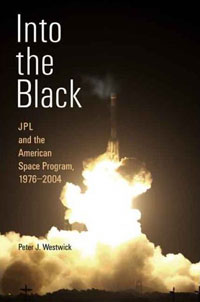Review: Into the Blackby Taylor Dinerman
|
| JPL is a unique and very American institution. |
The NASA connection did not stop JPL from doing useful work on the Strategic Defense Initiative in the 1980s. Indeed, the work they did on ultraviolet missile detection sensors, which was rejected at the time, might usefully be resurrected today as part of the future complex of space surveillance systems that are being considered.
In spite of all too frequent failures and being overshadowed by the Apollo program, JPL thrived in the 1960s. The successes of the Ranger and Mariner series of probes to the Moon, Mars, Venus, and beyond showed the world that even if America was not decisively winning the space race with the Soviets, it was definitely in the game.
It took a lot of hard political work but JPL’s leaders were able to convince the Nixon administration, which was not generally friendly to space science, that the Voyager mission to the outer planets was a worthy investment. The two Voyager spacecraft launched in 1977 suffered from numerous in-flight problems. Fixing these gave JPL unmatched know-how in the care and feeding of delicate spacecraft hundreds of millions of kilometers from Earth. No other institution on this planet comes close to having the expertise and “art” in building and managing deep space probes.
By the time of the two Voyagers historic encounters with Jupiter and Saturn from 1979 to 1981 both spacecraft were working fine and the pictures they sent back were far superior to the ones from the earlier Pioneer missions. They were so powerful that they help save NASA’s planetary sciences budget, which was threatened in the early eighties by cost overruns with projects such as the Galileo Jupiter probe and by the seemingly insatiable needs of the shuttle program.
JPL has historically been able to squeeze large achievements out of a relatively small budget. This is often contrasted with the manned space program. Westwick quotes one official who said, “It was almost a litmus test for a JPL person that they hated the manned space program.” Some of JPL’s more visionary leaders such as Bruce Murray, the director of JPL from 1976 to 1982, realized that robotic and human exploration go hand-in-hand. If anyone wants to see what a space exploration program might look like without a human element, they can take a look at the space budgets the British government provides to its researchers.
Westwick does draw attention to the way the long delay in the shuttle return to flight after the 1986 Challenger disaster helped cause serious cost overruns and failures in several of JPL’s major programs, most notably the Mars Observer. By the late 1980s NASA needed to rethink its approach to robotic exploration. The answer was the much-derided “Faster Better Cheaper” concept. This was already beginning to be implemented with the Mars Pathfinder project, led by JPL, and the NEAR asteroid rendezvous mission, led by APL, when Dan Goldin became NASA administrator in 1992.
| Westwick quotes one official who said, “It was almost a litmus test for a JPL person that they hated the manned space program.” |
At the same time the Defense Department’s Strategic Defense Initiative Organization was showing what could be done with a limited budget. The Clementine Moon mission, which proved the effectiveness of the sensors planned for the Brilliant Pebbles space-based missile defense system, indicated the way future missions could be run on a shoestring.
Under Goldin NASA would push the faster better cheaper concept beyond its natural limits. However, the idea has been, on the whole, a success. More missions are being flown and more widely varied space science is being done than ever before. While few, if any, scientists are happy with the overall funding levels, missions such as the New Horizons Pluto probe and the amazingly successful Mars Exploration Rovers would not have been possible under the old “Battlestar Galactica” approach.
Into the Black is a basic and academically sound look at JPL’s recent history. It would have been better with an appendix covering mission timelines and management responsibilities, but on the whole it will be a useful source for future space historians. It fails, though, to convey the vision that drives so many talented people to work at JPL and in the space industry.
JPL’s probes are scouting out humanity’s future, resources, workplaces, and homes. It will take another historian to put their work into this greater context. Westwick’s book is a good start, but there are many stories out there that still need to be told.
